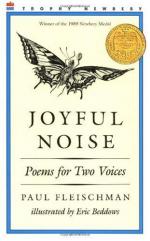
|
| Name: _________________________ | Period: ___________________ |
This test consists of 15 multiple choice questions and 5 short answer questions.
Multiple Choice Questions
1. Why might the cause of death of these insects be surprising to humans?
(a) We do not often think about how important the hot sun is to nature.
(b) We do not often think about how important the spring thaw is.
(c) We do not often think about the importance of water.
(d) We do not often think about the importance of the first frost.
2. The digger wasp creates what for its children?
(a) A room.
(b) A shelter.
(c) A bed.
(d) A nest.
3. Which bee believes life is relaxing and enjoyable?
(a) The worker bee.
(b) The bumble bee.
(c) The queen bee.
(d) The sweat bee.
4. A great deal of imagery and expressive vocabulary is also used to describe the ____________ movements of these beetles.
(a) Powerful.
(b) Straight.
(c) Circular.
(d) Lazy.
5. "Whirligig Beetles" describes ____________ of these beetles.
(a) The evening routine.
(b) Short life.
(c) The morning routine.
(d) The daily actions.
6. What does the digger wasp hope its children will do?
(a) Know how to take care of itself.
(b) Realize the sacrifices the parent made for its children.
(c) Enjoy the food and shelter.
(d) Live long, happy lives.
7. According to these beetles, this ____________ way of moving is the best way to move.
(a) Slow.
(b) Straightforward.
(c) Fast.
(d) Round about and indirect.
8. This sense reflects the movements of the whirligig beetle where?
(a) In the water.
(b) In the sand.
(c) In the trees.
(d) In the air.
9. The digger wasp wants its children to know that they were ____________.
(a) Considered.
(b) Loved.
(c) Prayed for.
(d) Envied.
10. What happens when the water boatmen reach their destination?
(a) They are allowed to rest.
(b) They start families.
(c) They turn around and head back to where they came from.
(d) They die.
11. "Requiem" is a _______________.
(a) Persuasive speech.
(b) Argument.
(c) Joke.
(d) Prayer.
12. This poem pays respect to these insects when?
(a) At the time of their deaths.
(b) At the time they go through metamorphosis.
(c) When they become adult insects.
(d) At the time of their births.
13. Why is the answer to number 90 repeated in the poem?
(a) This repetition creates the rhythm of the insects' oars as they slice through the water.
(b) This repetition is meant to annoy the reader.
(c) This repetition shows how important these insects are.
(d) This repetition shows how fast the boatmen must swim.
14. How are people like the digger wasp?
(a) People also make sacrifices for each other.
(b) People have wings.
(c) People are insects.
(d) People never live to see their offspring.
15. What else is reflected by what covers the pages of the poem?
(a) The way the beetles must have to hunt to find food.
(b) The confusion and frustration that must be caused by this many beetles.
(c) The way life must be in this habitat.
(d) The chaos this movement must create among this throng of beetles.
Short Answer Questions
1. "The Digger Wasp" tells of the life of a digger wasp as it prepares for what?
2. How does the queen spend her days?
3. What do the water boatmen and the digger wasp have in common?
4. "The Digger Wasp" is a very _________________ story.
5. The poet names _________________ insect species.
|
This section contains 535 words (approx. 2 pages at 300 words per page) |

|




